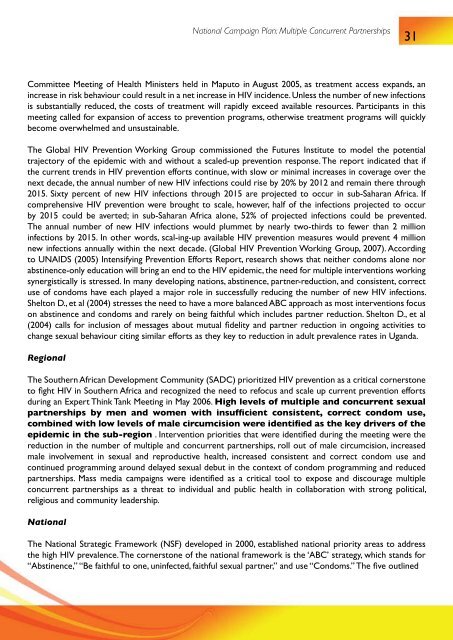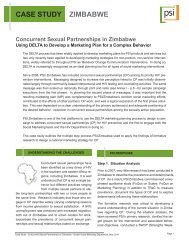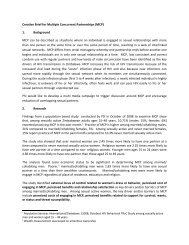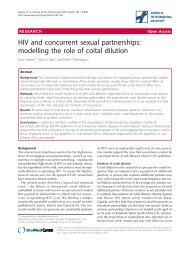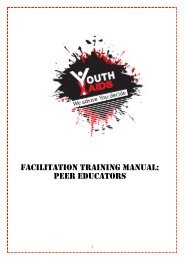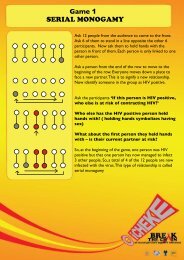O Icheke National Campaign Plan - CONCURRENT SEXUAL ...
O Icheke National Campaign Plan - CONCURRENT SEXUAL ...
O Icheke National Campaign Plan - CONCURRENT SEXUAL ...
- No tags were found...
Create successful ePaper yourself
Turn your PDF publications into a flip-book with our unique Google optimized e-Paper software.
<strong>National</strong> <strong>Campaign</strong> <strong>Plan</strong>: Multiple Concurrent Partnerships31Committee Meeting of Health Ministers held in Maputo in August 2005, as treatment access expands, anincrease in risk behaviour could result in a net increase in HIV incidence. Unless the number of new infectionsis substantially reduced, the costs of treatment will rapidly exceed available resources. Participants in thismeeting called for expansion of access to prevention programs, otherwise treatment programs will quicklybecome overwhelmed and unsustainable.The Global HIV Prevention Working Group commissioned the Futures Institute to model the potentialtrajectory of the epidemic with and without a scaled-up prevention response. The report indicated that ifthe current trends in HIV prevention efforts continue, with slow or minimal increases in coverage over thenext decade, the annual number of new HIV infections could rise by 20% by 2012 and remain there through2015. Sixty percent of new HIV infections through 2015 are projected to occur in sub-Saharan Africa. Ifcomprehensive HIV prevention were brought to scale, however, half of the infections projected to occurby 2015 could be averted; in sub-Saharan Africa alone, 52% of projected infections could be prevented.The annual number of new HIV infections would plummet by nearly two-thirds to fewer than 2 millioninfections by 2015. In other words, scal-ing-up available HIV prevention measures would prevent 4 millionnew infections annually within the next decade. (Global HIV Prevention Working Group, 2007). Accordingto UNAIDS (2005) Intensifying Prevention Efforts Report, research shows that neither condoms alone norabstinence-only education will bring an end to the HIV epidemic, the need for multiple interventions workingsynergistically is stressed. In many developing nations, abstinence, partner-reduction, and consistent, correctuse of condoms have each played a major role in successfully reducing the number of new HIV infections.Shelton D., et al (2004) stresses the need to have a more balanced ABC approach as most interventions focuson abstinence and condoms and rarely on being faithful which includes partner reduction. Shelton D., et al(2004) calls for inclusion of messages about mutual fidelity and partner reduction in ongoing activities tochange sexual behaviour citing similar efforts as they key to reduction in adult prevalence rates in Uganda.RegionalThe Southern African Development Community (SADC) prioritized HIV prevention as a critical cornerstoneto fight HIV in Southern Africa and recognized the need to refocus and scale up current prevention effortsduring an Expert Think Tank Meeting in May 2006. High levels of multiple and concurrent sexualpartnerships by men and women with insufficient consistent, correct condom use,combined with low levels of male circumcision were identified as the key drivers of theepidemic in the sub-region . Intervention priorities that were identified during the meeting were thereduction in the number of multiple and concurrent partnerships, roll out of male circumcision, increasedmale involvement in sexual and reproductive health, increased consistent and correct condom use andcontinued programming around delayed sexual debut in the context of condom programming and reducedpartnerships. Mass media campaigns were identified as a critical tool to expose and discourage multipleconcurrent partnerships as a threat to individual and public health in collaboration with strong political,religious and community leadership.<strong>National</strong>The <strong>National</strong> Strategic Framework (NSF) developed in 2000, established national priority areas to addressthe high HIV prevalence. The cornerstone of the national framework is the ‘ABC’ strategy, which stands for“Abstinence,” “Be faithful to one, uninfected, faithful sexual partner,” and use “Condoms.” The five outlined


